Managing Project Quality - Free eBook in PDF Format
 |
 |
|
Book Description - ISBN 978-1-62620-983-5 (52 Pages)
This eBook describes the process managing project quality. Every organization has its own predefined quality policies, and it is the responsibility of the project manager to translate these processes into project activities.
Chapter 1 - Managing Project Quality
This includes the processes and activities of the performing organization that determine quality policies, objectives, and responsibilities so that the project will satisfy the needs for which it was undertaken. It implements the quality management system through policy and procedures with continuous process improvement activities conducted throughout, as appropriate. Quality planning is about deciding what quality means for this particular project and its deliverables. This information makes up the quality plan, which is part of the project plan. Planning for quality is no different from planning for any other task. It aims to produce a description of what the quality requirements are and how they are going to be achieved. As well as providing a definition of quality the quality plan also acts as a communication tool to engage key stakeholders in the quality management process.
Chapter 2 - Quality Management Techniques
Most of the tools and techniques described here are based on statistical analysis and are most appropriate where the project deliverables are products that can be measured in some way. For example, if parts are being produced on a production line then it will be straightforward to measure dimensions, tolerances, failure rates, etc.
Chapter 3 - Project Management and ISO Quality Management
The ISO approach to quality management emphasizes: customer satisfaction, prevention over inspection, continuous improvement, management responsibility and the cost of quality.
Chapter 4 - Quality Assurance
Quality assurance is part of the executing process and is concerned with making sure that the quality objectives are met. It is focused on process improvement. This process also provides an umbrella for continuous process improvement, which is an iterative means for improving the quality of all processes so as to reduce waste and eliminate activities that do not add value.
Chapter 5 - Quality Control
Quality control involves monitoring specific project results to determine whether they comply with the relevant quality standards and identifying ways to eliminate the cause of unsatisfactory results. In other words, it attempts to answer the questions: Is the project meeting its quality requirements? If not, how can this be addressed?
Chapter 6 - Testing Project Deliverables
The more experienced project managers ensure that an element of testing is present throughout their project and not just at the implementation stage. They will carefully plan that sufficient funds and resources are available so that the testing can be thorough.
Chapter 7 - Quality Audits
The rationale behind project audits is to assess whether the chosen methodology provides the project manager with all the procedures and processes that will ensure project success. The audit report will identify the major concerns of the project stakeholders, its sponsor and its team members and then present recommendations of how flaws, issues and concerns could be overcome to keep the project on track.
Chapter 8 - Post Implementation Audits
One of the most important audits for highlighting improvements to an organization is the post implementation audit. It is slightly different to 'lesson's learnt' because it looks at how project objectives and activity attainment compares to what was written in the overall project plan and its functional area plans e.g. cost, scope, quality etc.
| You will learn: |
|
![]()
![]()
Background
There is an old saying that goes "If something is worth doing, it is worth doing right." That is certainly the case when undertaking any kind of a project within your organization. There is little point to taking on a new project, only to complete it to a low standard of quality that will not reflect well on you or your organization.
 |
In order to have pride in what you have accomplished, and for it to benefit the organization in the long run, the quality needs to be up to the standards of everything else that you do.
Project quality management is the process of establishing a level of expected quality at the start of a project, and then maintaining that quality throughout until the project has been completed. There are several areas that are often at the root of poor quality and are shown in the diagram below.
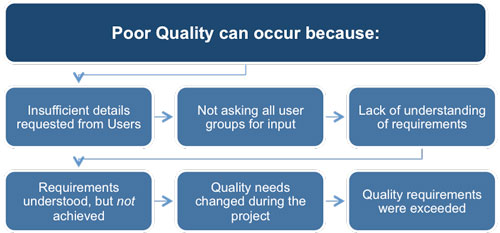 |
It might be easiest to think of this concept in terms of an example - such as a new product that you organization is trying to produce. Rather than simply aiming to produce a product that can accomplish a given task, you may set out to create a product that can accomplish that task while also meeting various other measures of quality. Things like durability, materials used, methods of construction, and more can all be ways that the quality is measured.
Organizations who are serious about not only present profits but also future growth take quality control very seriously. Everything that goes onto market representing your brand name is going to be seen as a reflection of the company as a whole. Even one or two sub-standard products can harm the reputation of an otherwise outstanding brand name.
There are three stages a project manager must go through to manage project quality properly as shown in the diagram.
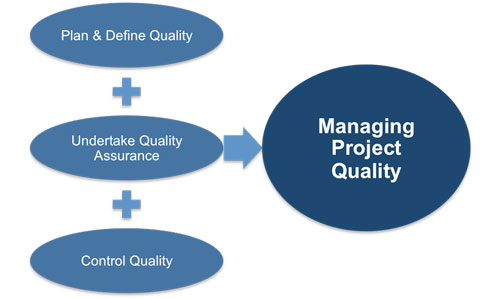 |
Planning Quality Management
Before the project gets underway, it is best to analyze the level of quality that you intend to put into a given product. It isn't good enough just to say that you wish to make the product to 'as high of a standard as possible'. Quality is forever linked to cost, and so you must take your project budget into consideration as part of this planning process. Certainly you would use the best possible materials available if you can afford them, but the product must be cost-effective to be of any use to the company.
The process of planning quality can be complex because it has to balance the interests of overall quality with the reality of a budget and is an essential part of project communication throughout the project life cycle.
 |
One of the important parts of this stage of the process is outlining exactly how quality is going to be measured during the project.
1) Are there certain tests that can be done along the way?
2) What are industry standards for this kind of product, and how are you intending to compare to them?
Being specific with what exactly will define quality for your project goes a long way toward making the next steps in project quality management easier and more effective.
Performing Quality Assurance
Now that your quality plan is in place, the next step is outlining how you are successfully going to meet that plan and put it into action. The methods that you intend to use during the project itself need to align with the quality goals that have been outlined previously.
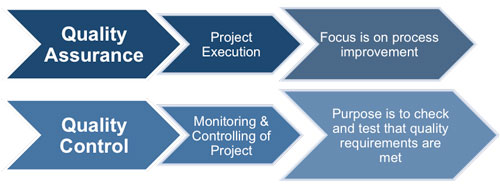 |
Toward this end, experience can be greatly beneficial to understanding what kind of processes lead to quality results. If you have people within your organization who have done this kind of work before and can offer direction in terms of quality assurance, it is greatly important to use that knowledge to your advantage.
You don't want to be making quality assurance adjustments 'on the fly'. Every bit of time that is put into a project is directly associated with a cost, so wasting time is only going to increase the overall expense of the project in the end.
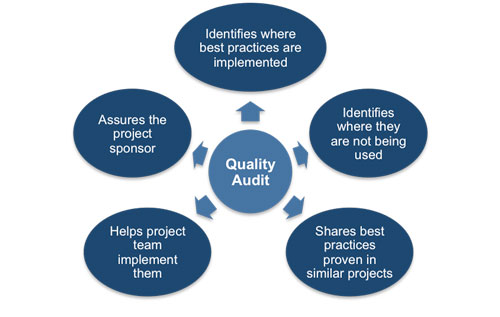 |
Rather than having to scramble mid-project to make quality adjustments, putting a structured, independent review as part of your project quality assurance is essential. These quality audits will determine the 'fit' of project activities to the policies of project and its organization.
Controlling Quality
This is what happens once the project is underway. All of the great planning that has already been done won't do you any good if it isn't adhered to closely along the way. Quality control might be the most important piece of the whole project quality management puzzle because correcting any problems as soon as possible will save you wasted time and money down the line.
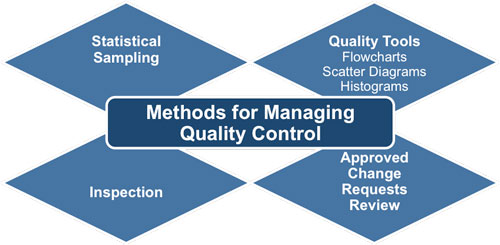 |
Testing is probably going to be the biggest piece of quality control for most organizations. There are a variety of tools and techniques that can be used to monitor and control quality of work packages and activities throughout the project. This includes such tools as:
• Prioritization matrices
• PDPC
• Tree diagrams
• Interrelationship digraphs
• Affinity diagrams
• Matrix diagrams
• Activity Network Diagrams
If you are developing a new product that you intend to take to market at the completion of the project, it should be tested throughout to make sure it is tracking properly with the guidelines that you have set up. If the tests of the product aren't meeting your expectations, you will know that something needs to be fixed or improved in order to improve quality.
In many ways, the longevity of your organization may be determined by how well you handle project quality management for each new initiative that is undertaken. Organizations that routinely produce low-quality goods are rarely in business for long, even if they are trying to compete at a low price point.
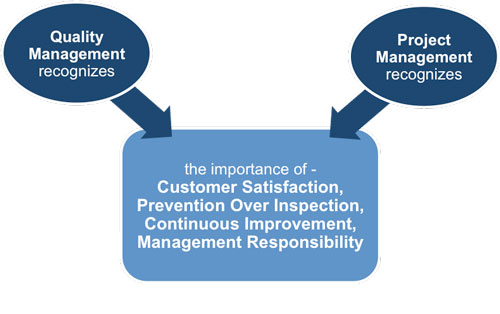 |
Quality wins out in the end more often than not, so project quality management is a piece of the puzzle that shouldn't be left out. Like all other pieces of project management, it starts will thorough preparation before the project is even underway.
Laying out the quality expectations for the project, as well as the methods that should allow those expectations to be met, is one of the first priorities of any new project. The plan for quality must be in line with the budget for the project, plus the skills and equipment are in place to make it happen, good quality control should be the only thing standing between you and a satisfactory result.


